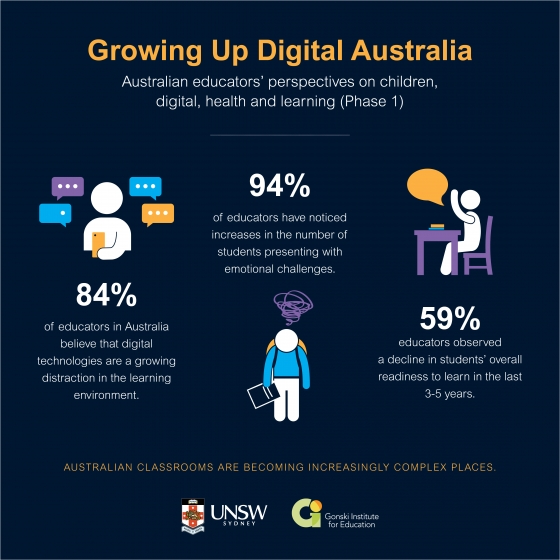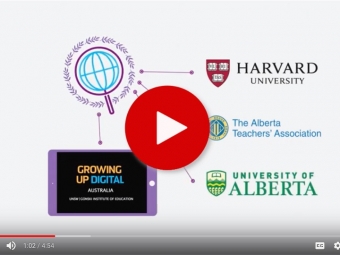The first in a series of Growing Up Digital Australia reports by the Gonski Institute for Education at UNSW Sydney paints a worrying picture of changed learning conditions in Australian schools. Well before the COVID-19 pandemic hit Australia, children’s significant access to digital technology and its impacts on learning and wellbeing had become a major concern for educators.
Key findings show nine out of 10 teachers and principals in Australia have observed an increase in students with emotional, social and behavioural challenges in school today compared to just five years ago. Three out of five Australian educators have seen a decline in students’ readiness to learn and two-thirds have observed more children arriving at school tired.
Now, with more than 85% of children across Australia being taught remotely at home, with a heavy emphasis on learning using media and digital technology, this research takes on an extra dimension. Children have entered a period of even greater exposure to screen-based technologies where no-one can be sure what impact, both positive and negative, this will have.
“What is happening with our kids now is the biggest educational experiment in history,” says Professor Pasi Sahlberg, the report’s co-author, Professor of Educational Policy and Deputy Director of the Gonski Institute for Education. “As adults, we have much to learn about their habits, and the benefits and pitfalls of screen-based technologies for them. Growing Up Digital Australia sets out to do just that.
“Based on our research, it is clear the problems facing young people today are complex. Simply banning devices in schools or homes will not help students navigate the digital minefield.”
This first research phase of Growing Up Digital Australia will form crucial benchmark data as we start to understand what the COVID-19 world and the post COVID-19 world will look like for children. The study also suggests there are some serious concerns regarding access and equity when teaching and learning move to rely more on available technologies in schools and homes.
“Kids today are online more than ever before, staying connected on their devices for school and to socialise with friends,” says Australian eSafety Commissioner Julie Inman Grant. “This constant exposure can not only affect their performance in the classroom, but also has real implications for their safety and emotional wellbeing outside of it.
“We know that when online exposure goes up, so do the risks of abuse, cyber bullying and even unwanted contact from strangers.
“This unique study gives us another sobering glimpse into how the online world can have real impacts on our children’s lives, but at the same time it also provides us with a great opportunity to find new ways to manage these issues now and into the future.”
About the research
The Institute has partnered with Harvard Medical School, the University of Alberta and Alberta Teachers Association on the international digital technology, learning and health research project Growing Up Digital in Australia. The project has the potential to be the world’s largest study of technology, learning and health impacts on K–12 students.
The study’s phase 1 findings were drawn from 1876 responses to a survey of teachers, principals and school support staff in all sectors (Government, Catholic and Independent) from preschool to Year 12 which ran from September to the end of the school year in 2019.
Key facts
- 43% of Australian teachers and principals believe digital technologies enhance their teaching and learning activities., while 84% believe digital technologies are a growing distraction in the learning environment.
- 60% of teachers believe technology has positively impacted the learning experience for students with disabilities.
- 59% of respondents observed a decline in students’ overall readiness to learn in the last 3–5 years.
- 78% of teachers say students’ ability to focus on educational tasks has decreased.
- 83% of teachers agree that students’ socio-economic circumstances have some impact on access to technology they need for learning in school.

